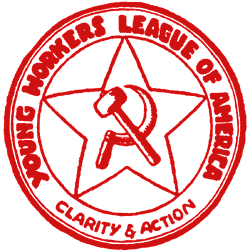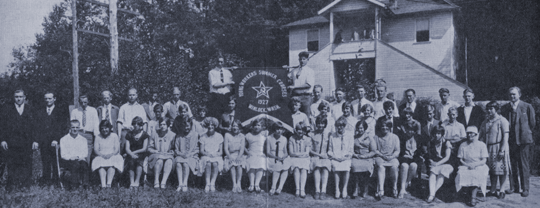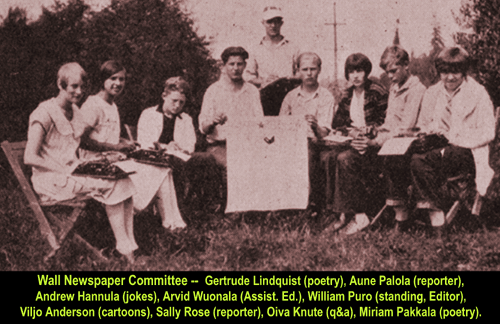 ORGANIZATIONAL
HISTORY
YOUNG
COMMUNIST LEAGUE OF AMERICA
ORGANIZATIONAL
HISTORY
YOUNG
COMMUNIST LEAGUE OF AMERICA
The split of the Socialist Party of
America in 1919 affected its youth section, the Young People's
Socialist League (YPSL), as well. A segment of the organization
departed its ranks amidst the controversy, while the organization
attempted to steer to a position of neutrality between the warring
factions of American Communism, the Communist Party of America
and the Communist Labor Party of America. While both of those
organizations approved the operation of a youth section in principle,
in practice they had other pressing concerns and did nothing
along that line. Loyalists to the SPA attempted to regain the
organization for the mother organization, and amidst factional
rancor and financial poverty, the national organization dissolved,
as did most of the local units of the organization.
It was not until the 2nd Convention
of the United Communist Party [Kingston, NY, Jan. 1921] that
a serious effort was made to establish a Young Communist League
of America. The
convention resolution may be downloaded here. "H. Edwards"
was appointed national organizer by the party, provisional rules
and first leaflets were drawn up, and organizational work was
begun in all the major cities in which the UCP had a presence.
By April of 1921, the YCLA claimed that "about 20 groups"
were "definitely organized."
[fn. "H. Edwards,"
Report to the 2nd World Congress of the YCi," NARA M-1085,
reel 939, doc. 122.]
1. Founding Convention
YCLA --- Bethel, CT --- April 20, 1922.
It was not until April of 1922 -- after
the United Communist Party had joined the Communist Party of
America to form the unified "Communist Party of America,
Section of the Communist International" -- that a convention
was held for the YCLA. The underground gathering was held in
Bethel, Connnecticut on April 20, 1922. The underground YCL remained
in existence throughout 1922 and into 1923, duplicating the role
of the underground CPA vis-a-vis its legal arm, the Workers Party
of America.
[fn. Theodore Draper,
The Roots of American Communism (NY: Viking, 1957), pg.
344.]
 YOUNG
WORKERS LEAGUE OF AMERICA
YOUNG
WORKERS LEAGUE OF AMERICA
1. First National
Convention YWLA --- Brooklyn, NY --- May 13-15, 1922.
The Founding Convention of the Young
Workers League of America approved a manifesto, program, a set
of resolutions, and a constitution
for the organization. Membership in the organization was open
to "all proletarians" between the ages of 14 and 30.
There were originally no constitutional links between the YWL
and the Workers Party of America -- ostensibly its parent organization.
The YWL was to hold annual conventions,
governed in between these events by a National Executive Committee
of 7, of whom at least 5 were to be residents of the city in
which headquarters were located. Five alternates were also chosen,
to be filled into the NEC as vacancies arose according to the
order of votes received for each alternate. Chicago was chosen
as the headquarters city by the founding convention and the group
maintained its first headquarters at 1145 Blue Island Avenue,
Room 9, Chicago, IL.
The 1st Convention elected the following
officers:
National Secretary: Martin Abern.
National Executive Committee:
??? (x 7).
NEC Alternates: ??? (x 5).
The YWL published The Young Worker
as its official organ. It also had a "Junior Section"
for children between the ages of 8 and 14, for whom a small monthly
magazine called The Young Comrade was published.
2. 2nd National
Convention YWLA --- Chicago, IL --- May 20-22, 1923.
The 2nd Convention of the YWLA approved
a set of resolutions on International Relations, the Economic
Demands of Youth, Education, Miliatarism, Sports, Press, Foreign
Language Sections, and the Relationship of the YWL to the Workers
Party of America. It also adopted a "Thesis on the Organization
of Shop Nuclei," faulting the territorial form of organization
for a failure to make connection with the masses of youth and
calling for a restructuring of the organization on a shop basis.
The 2nd Convention elected the following
officers:
National Secretary: John Williamson.
National Executive Committee:
??? (x 7).
NEC Alternates: ??? (x 5).
At the end of 1923, the YWL claimed
(rather optimistically, it would seem) a membership of about
4,000, organized in 150 branches spread across 100 cities. A
membership for the Junior Section of 2,000 in about 30 cities
was also asserted. Both of these extremely round figures are
to be regarded with suspicion until documentary evidence as to
the actual size of the dues-paying membership comes to light.
At the end of 1924, the YWL claimed
a membership of between 3,500 and 4,000 in 150 branches. The
above caution as to the veracity of this number applies.
3. 3rd National
Convention YWLA --- Chicago, IL --- Oct. 4-6, 1925.
The 3rd Convention of the YWL was marked
by a severe factional split between supporters of William Z.
Foster and of C.E. Ruthenberg that paralleled the split in the
adult party. The report of the credientials committee seating
a majority of the Ruthenberg groups delegates was approved by
a margin of 29-20. In the debate on the report, Jack Stachel
of the Ruthenberg group declared that the YWL had a membership
estimated at between 1800 and 1900 and claimed majority support
for his faction.
James P. Cannon spoke to the convention
about his differences with Foster. William Z. Foster also addressed
the gathering, concluding his speech with the words "I am
for the Comikntern from start to finish... and if the Comintern
finds itself cris-cross with my opinions, there is only one thing
to do and that is to change my opinions to fit the policy of
the Comintern." Max Bedacht reported for the Ruthenberg
majority group, which was the majority faction of the CEC of
the WPA.
The 3rd Convention elected a 20 member
National Executive Committee consisting of 10 members from each
faction. The officers were as follows:
National Secretary: Samuel Darcy.
National Executive Committee:
Joseph Angelo, Samuel Darcy, Samuel
Don, John Harvey, William Herberg, Nat Kaplan, Valeria Metz,
George Papcun, H.V. Phillips, Max Salzman, Al Schaap, Max Shachtman,
Peter Shapiro, Morris Schindler, William Schneiderman, Jack Stachel,
Patrick Toohey, John Williamson, Sam Winocur, Herbert Zam.
During 1925 the Young Pioneers' League
of America was established for children under 14 years of age,
replacing the Junior Section of the YWL. The YPLA's magazine
was a monthly entitled The Young Comrade.
YOUNG
WORKERS (COMMUNIST) LEAGUE OF USA
Youth
Conference --- Bellaire, OH --- Feb. 28, 1926.
Youth
Conference --- New York, NY --- March 5, 1926.
Pioneer
Camps and YWL Summer Schools
The Workers Party's first youth summer
school was held in 1925 at Waino, Wisconsin. About 50
students attended and the program lasted for four weeks.
The Finnish Federation, the largest
in the WPA, adopted the summer schools as an important task.
During the summer of 1926 the YWL ran a national school
in Chicago, with 16 students, as well as three district schools,
based in Waino, WI; Waukegan, IL; and Winchedon, MA. These schools
conducted full-time 5 week program of courses at Waino, 4 weeks
at the other schools. Approximately 140 youngsters attended.
The Young Pioneers, the junior section
of the YWL, held three summer camps in 1926, in Chicago, New
York City, and Boston, attended by 700 to 800 children.
During the summer of 1927 there
were four district schools held -- Boston, Ohio, Waino, WI, and
Winlock, WA. The Wisconsin and Washington schools conducted an
ambitious 6 week program, while the other two schools conducted
a 5 week program. Approximately 160 young communists took part.
As you may discern from the photos of Waino (above) and Winlock
(below), the average age of participants varied substantially
between specific summer schools. In an essay which he wrote for
the 1927 Yearbook of the Winlock School, Director Oliver Carlson
advocated a rather older rather than younger average age, stating
that "the boy or girl of 14, 15, or 16 years who is still
in school has not as yet been forced to shift for himself, to
make his own living, and to feel the pressure of the class struggle.
To such a one the class war and all other theories relating to
it cannot be duly appreciated."

The Pacific Northwest school was held
at Winlock, WA from July 10 to Aug. 20, 1927 and was attended
by 42 students -- 24 girls and 18 boys. Age of participants ranged
from 14 to 23, with the great bulk between 15 and 18. The students
followed the following topics: Sociology, American Social and
Labor History, Marxian Economics, Class Struggle History and
Theory, Imperialism, Problems of Socialist Reconstruction, Cooperation,
Current Events, Public Speaking, and Theory and Practice of Young
Workers' Organization. 28 of the students came from 15 towns
in Washington state and 13 students came from 6 towns in Oregon.
In addition, there was one participant from Rock Springs, WY.
Of the participants, 23 were members of the YWL, 1 was a member
of the W(C)PA, and 19 were non-party. As funding for the camp
was raised through the pages of the Astoria, OR communist newspaper
Toveri, it should come as no surprise that nearly of the
participants had clearly Finnish surnames. Director of the Winlock
school was Oliver Carlson, who had been involved in earlier party
youth schools in New York, Chicago, and Wisconsin.
Classes began at 9 am and carried through
until 2:50 pm, with an hour for lunch. Students had additional
less formally directed activity, which included research, recreation,
songs, and athletics until 4:30 pm. Monday Evenings were spent
in YWL nuclei meetings, Friday evenings featured lectures, and
plays and entertainment took place on other evenings.
The students elected a six member discipline
committee, which set rules for the school, times that students
were to be in their quarters, and so on. A chart headed "Roll
of Dishonor" was posted to note rulebreakers and thereby
maintain discipline.
Five Young Pioneers summer camps were
held in 1927, located in the Boston, New York, Ohio, Detroit,
and Chicago districts.
Information about 1928 is less
complete. At a minimum, there was once again a party summer school
held in Woodland, Washington attended by 54 students -- 30 girls
and 24 boys. The School was held from June 24 through August
4, 1928. The composition was rather older than the 1927 Pacific
Northwest school, with 11 students between the ages of 25 and
34. Washington remained the home of the greatest percentage of
students (21 of the 54), closely followed by a contingent of
20 from California (11 from Los Angeles, 9 from Northern California).
An additional 12 students were from Oregon and 1 hailed from
Vancouver, British Columbia. It seems that in contrast to 1927,
almost all participants were members of the YW(C)L or the Workers
(Communist) Party (35 and 15, respectively). Only a minority
of participants had Finnish surnames, again in contrast to the
1927 school.
In addition to director Oliver Carlson,
a cook and a technical manager, three instructors joined the
faculty: Marion Gray (Agitprop Director of District 12), Al Schaap
(District 12 Organizer), and Frank Waldron [Eugene Dennis] (Subdistrict
Agitprop Director in District 13). Student committees were formed
for athletics, entertainment, photography, library, publicity,
wall newspaper, student annual, and discipline.
On the 4th of July, students were transported
by truck to the opening of Tualatin Park, 8 miles south of Portland.
Revolutionary songs were sung and public speeches were delivered
by Henry Routtu (on the YWL), Fred Walker (on Workers Education),
and Rose Rubin (on the significance of July 4th to the working
class). The students also took a field trip to a non-union lumber
mill in Longview, Washington on July 11th. A group of students
also agitated against militarism at Vancouver, Washington that
same day at a Citizens Military Training Camp.
Plans were set in motion to establish
a similar school in California the following summer.
According to the 1930 edition of The
American Labor Yearbook, the Young Communist League "based
on dues payments" had a membership of about 500 in 1926,
700 in 1927, and 1,860 for the first ten months of 1928. As this
is a hostile source, these numbers should be regarded with caution
until verifcation with internal documents is possible.
4. 4th National
Convention YW(C)L USA --- New York, NY --- October 30-XX, 1927.
A partial list of delegates published
in The Young Worker issue of Nov. 1, 1927 included:
D1 (Boston): Kay, Shohan, Kangas. D2 (New York):
Plot, J. Harrison, Miller, Rubenstein. D3 (Philadelphia):
Bender, Feldman, Carroll. D5 (Pittsburgh): Minerich,
Jaffe. D7 (Detroit): Joe Roberts. D8 (Chicago):
Lurye, Glotzer, Green, Novack. D9 (Superior/Twin Cities):
Tenhunen, Boverky, Bernick, Sankary. WPA: Bedacht,
Wolfe, Stachel, Weinstone, Bittelman.
5. 5th National
Convention YW(C)L USA --- New York, NY --- April 26-XX, 1929.
The 5th National Convention changed
the name of the organization to "Communist Youth League
of USA." The change was short-lived, as by the 6th Convention
the name of the organization had changed yet again, to "Young
Communist League of USA."
The main report was delivered by Herbert
Zam, who spoke on "The Report of the NEC, the Struggle Against
the Right Danger, the Position of the Young Workers, and the
Tasks of the League." An organizational report was also
delivered by Sam Darcy.
YOUNG
COMMUNIST LEAGUE OF THE USA
6. 6th National
Convention YCL USA --- New York, NY --- July 4-XX, 1931.
The 6th National Convention was attended
by 63 delegates, 16 alternates, 17 members of the National Executive
Committee, and 17 fraternal delegates. According to statistics
published in The Young Worker, this group was said to include
69 members who were 22 years old or younger and to be comprised
of 61 native-born whites, 10 native-born blacks, and 18 foreign-born.
"July
Plenum" --- New York, NY? --- July XX-XX, 1933.
7. 7th National
Convention YCL USA --- New York City? --- June 22-27, 1934.
8. 8th National
Convention YCL USA --- New York City --- May 2-5, 1937.
9. 9th National
Convention YCL USA --- New York City --- May 11-15, 1939.
sources: American Labor Year Book. (NY: Rand School
of Social Science, various dates), 1923-24: pp. 166-167. 1925:
pp. 165-166. 1926: pp. 254-256. 1927: pp. 135-136. 1930: pg.
142. 1932: pp. 116-117. The Young Worker (1927-1929),
passim. Red Dawn: Commencement Annual of the Northwest Young
Workers Summer School. (Astoria, OR: Pacific Development
Society, 1927). Red Student: Commencement Annual of the Pacific
Coast Workers Summer School. (Astoria, OR: Pacific Development
Society, 1928).




